 Multiple Choice Questions
Multiple Choice QuestionsThe Galapagos finches were an important clue to Darwin's thinking about the origin of species. These finches are believed to have descended from a single ancestral species that colonized the Galapagos archipelago, America, over a short period of time. The Galapagos finches differ in their beak shape and size. Different species feed on seeds that vary in size and hardness.
Which of the following is the most likely explanation for these patterns?
The finches represent an example of directional trend in beak size from small to big.
Beak shapes changed in response to different seed types and these changes were inherited by subsequent generations.
The ancestral finch already had all the beak variations and different lineages formed that were specialized to eat different seed types.
The finches represent an example of adaptive radiation in which beak variation was generated by mutation followed by selection by different seed types.
In order to demonstrate that the long tails of males attracted females in a bird species experiments captured and cut the tails of 'n' number of males and monitored the number of females mated by each male. They had two types of control in the experiment.
(i) 'n' males that were not captured.
(ii) 'n' males that were captured, had their tails cut and then stitched back to attain the original size.
The males with cut tails mated with a significantly smaller number of females than both the controls. Which of the following alternative explanations is NOT ruled out by the experiment?
The stress of cutting tails affected the performance of males.
The time wasted in the capture reduced mating opportunities of males.
Females avoided any deviation from normal.
Females chose males randomly
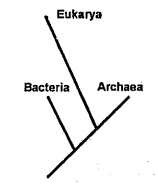
In the phylogenetic tree above, branch-lengths are drawn proportional to the number of changes along a lineage. The following inferences were made from this tree.
(A) Bacteria are more closely related to Eukarya than to Archaea.
(B) Bacteria and Archaea are more similar to each other than either is to Eukarya.
(C) Archaea and Eukarya diverged from each other after their common ancestor diverged from bacteria.
Which of the following represents a combination of correct inference?
(A), (B) and (C)
(A) and (B) only
(B) and (C) only
(A) and (C) only
While attempting to create a disease model of poliomyelitis in mice, it was found that mice cannot be infected with the said virus. Since human beings are susceptible to this viral infection, which kind of transgenic mouse model that can be infected with polio virus? Select the right approach from below:
A mouse expressing surface protein of polio virus.
A mouse expressing the human receptor gene which makes cell surface protein for docking and internalization of poliovirus.
A mouse expressing human MHC class II invariant chain.
A mouse expressing human receptor gene which makes cell surface protein for docking and internalization of poliovirus along with a gene designed to express surface protein of this virus at puberty.
Protoplast fusion is used in plant tissue culture for various applications.
In protoplast fusion:
(A) naked plant cells are used.
(B) transfer of organelles is not possible.
(C) partial genome transfer is involved.
(D) cells from two different plants can be mixed together and forced to fuse.
Which one of the following combinations of the above statements is correct?
(A), (B) and (C)
(A), (C) and (D)
(A), (B) and (D)
(B), (C) and (D)
Which of the following is a mismatch between the plant drug and its source?
Codeine - Papaver somniferum
Vineblastine - Catharanthus roseus
Quinine - Cinchona ledgeriana
Digitalin - Artemisia annua
Which of the following curves correctly represents the process of ethanol production yeast?
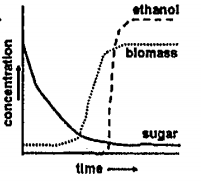
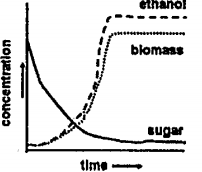
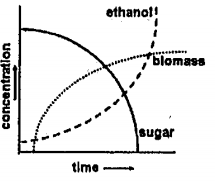
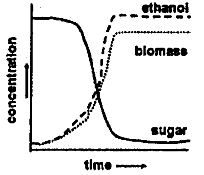
D.

Among the given options, graph 4 represents the process of ethanol production by yeast.
Inbreeding for 5 generations led to the production of homozygous transgenic mice. However, these homozygous males or females were infertile. Which of the following approach is most preferable and economical to obtain heterozygous transgenic animals continuously?
Moretransgenic founder (1st animal) should be generated.
Crossing (breeding) of transgenic mice with wild type mice in earlier generations should be done for the continued production of transgenic heterozygous offspring.
Inbreeding should be avoided after 5th generation.
Homozygous transgenic mice should be mated with wild type for continued production of transgenic heterozygous offspring.
Following are few statements for regenration of plants from explants/ tissues
(A) Cytokinin is required for shoot development.
(B) Auxin is required for shoot development.
(C) Auxin to cytokinin ratio is very important.
(D) Jasmonic acid is required for both root and shoot development.
Which of the following combinations of above statements is true?
(A) and (C)
(B) and (D)
(A) and (D)
(B) and (C)
A set of neonatal mice are divided into four groups. Group 1 neonates were not primed with any antigen. Group 2 neonates were primed with KLH. Group 3 neonates were primed with KLH but thymectomized. Group 4 neonates were KLH-primed, thymectomized, but reconstituted with KLH-specific CD4+T cells. All these mice, when grown adult, were challenged with KLH and the anti-KLH IgG antibody was measured in sera. Which of the following is the correct order of magnitude of antibody response?
[> = greater than, ≥ = greater than or equal to]
Group 1> Group 2 > group 3 > Group 4
Group 2 > Group 1 > Group 3 ≥ Group 4
Group 2 > Group 3 > Group 1 > Group 4
Group 4 > Group 1 > Group 2 ≥ Group 3
